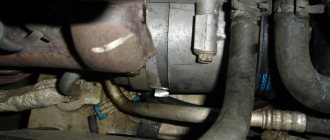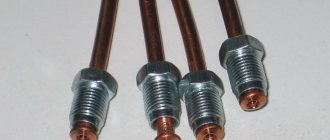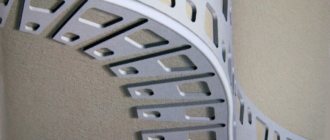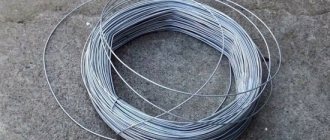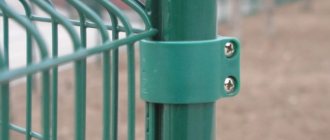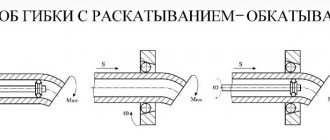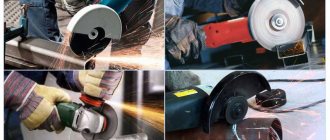When carrying out work on water supply and heating communications, as well as when installing heated floors, copper pipes are often used. Copper is generally a popular material in this area. Products made from it are durable, yet flexible and not subject to corrosion. When laying copper pipelines, there is often a need to bend the pipe at a certain angle. And since many owners make repairs on their own, the question arises: how to bend a copper tube correctly at home?
Copper pipes are bent using several methods, one of which involves the use of a pipe bender
Bending pipes using a spring
Before you get to work, you should prepare. Make sure that work is carried out in a well-ventilated area or in an open area. A yard or garage works great if the gate is open. Additionally, you will need a heating tool regardless of the bending method.
There are several ways to bend a pipe at home. They differ in the degree of complexity, high cost of materials and the need to use special equipment.
A popular method is bending with a spring. First you need to choose the right tool: the spring must be made of high-quality steel, have frequent turns and a thick core. The size also matters: make sure that the spring fits freely inside the tube. It is better if both products are approximately the same in length. If the spring is still shorter, attach a piece of wire to it so that you can remove it later.
If you need to bend a very thin pipe, then the spring for bending copper pipes needs to be selected a little larger so that the pipe itself fits inside it.
With the help of a spring it is easy to give the copper pipe the desired shape, you just need to choose a spiral of the appropriate size
Now we heat the workpiece using a device: at home you can use either a gas heater or a blowtorch. When the temperature is high enough, the color of the pipe will change and it will become flexible enough that you can easily shape it into any shape you like. After bending, leave the workpiece to cool.
Helpful advice! Remember that you should only remove the spring after the pipe has cooled down.
When is such a connection needed?
Air duct systems are constructed from metal pipes of two types of sections: rectangular and round, or flat oval. Situations arise when it is necessary to switch from one type to another in the same air route. As a rule, this is due to either technical necessity or design decisions.
In order to smoothly and reliably connect different types, special structures are made: transitions from one section shape to another shape.
They are made from galvanized or stainless steel with a thickness of 0.5 to 2 mm, using the rolling method. The photo below shows an adapter from round to square. One part of the box has a rectangular hole, the other has a round hole.
In accordance with the type of execution, the arrangement of sections can be either symmetrical or asymmetrical. The diagram below shows 6 ways to place round holes.
Bend the pipe using sand
There is another option for bending a copper pipe at home. To do this, you do not need special equipment or even devices like metal springs. You can simply heat the pipe and bend it. However, to avoid deforming the product by improper action (this happens often because copper pipes are very flexible), resort to the following method.
All you need is a supporting surface, a heating tool, two pieces of wood having a diameter to which you want to bend the product, and the usual building material - sand.
Helpful advice! It is better to take river sand, without large inclusions, dry and sifted. It will reduce the risk of deformation when bending copper pipes.
First, plug one end of the pipe with a wood plug, then fill the cavity with sand, periodically shaking and tapping the pipe to ensure maximum uniform and dense filling. Then plug the other end of the product with the same stopper. Now you can heat and bend. Do this very carefully, resting the tube on a hard surface, because it heats up quite quickly and is easily deformed.
A pipe filled with sand should be bent very carefully so as not to deform it.
Try not to overdo it with heating: the sand puts pressure on the walls, and they may simply burst. Having given the product the desired shape, place it in cold water to cool quickly. Then remove the plugs and pour out the sand. You need to pour out the sand only after the workpiece has completely cooled. In addition, it is recommended to blow out the pipe so that there is no debris in the future water supply.
Pipe bender: classification and application
How else to bend a copper tube at home without extra effort? This can be done using a special prior - a pipe bender. With its help you will save time, and pipe bending will be easier.
The device is a mobile tool that performs bending according to the parameter you specify by fixing one end of the pipe and moving the other. In this case, the place where the pipe is bent is fixed in one position.
Depending on the principle of operation, pipe benders are divided into three types:
- Lever (manual). The design consists of two levers with a special shoe and a bending template. To set the desired angle, refer to the marks placed on the surface of the levers. Fix your workpiece in the bracket, align the zero marks and you can do the job. Using this device, you can easily bend pipes at home, even at an angle of 180 degrees.
- Hydraulic – professional level devices. They are able to bend much faster, and the hydraulic principle of operation eliminates the need for great effort.
- Electric ones are perfect for industrial and commercial purposes, as they are designed for large volumes of work. They operate using an electric drive and are similar to their manual counterparts. The pipe is placed in a bracket and bent according to the parameters specified using special segments.
It is best to use a special tool for bending pipes - a pipe bender.
Helpful advice! Select equipment according to the parameters of the product being bent. If you are bending a pipe of small diameter and length, then a manual pipe bender, spring or sand will be sufficient. Only hydraulic and electric tools can handle large workpieces.
Specifications
According to their shape, such transitions are divided into square and rectangular. The transition from a square to a round cross-section has a rectangular part that is more voluminous, and therefore is not suitable for passage in low rooms. Three types of metal are usually used as materials for such transitions:
- • Stainless steel. Such air ducts are not afraid of corrosion and damp rooms; even after a year they will shine like new.
- • Cink Steel. This steel is slightly less durable than stainless steel, but is also almost 25% cheaper. The choice is yours whether to use stainless or galvanized steel. The round air duct made of galvanized steel does an excellent job of removing humid air and air contaminated with debris.
- • Aluminum. The light weight of this metal allows structures made from it to be placed on weak mounts at high altitudes.
Methods for bending pipes at home
The ways to bend pipe elements at home without using factory tools are quite varied and include physical and temperature effects.
Application of the hot method
Most metals and alloys heated to high temperatures become more ductile and more easily susceptible to plastic deformation. Such materials include: steel, copper, aluminum, brass, duralumin, aluminum-ferrous bronze. During heat treatment, zinc alloys, gray cast iron, and tin bronze become brittle. Moreover, the higher the heating temperature, the greater the ductility - for steel heated to 700ºС. the deformation force required is 4.5 times greater than for products with a temperature of 1200ºС.
Also, all heated metals become 25 - 30 times less strong than in a cold state - this allows workpieces to be easily bent without strong internal resistance, while obtaining the smallest bending radius.
When metal is exposed to temperature, the main danger is burnout - in this case, when heated, the metal melts, oxygen penetrates into its structure and brittle, destructible oxides are formed.
The burnout effect is irreversible and is a defect, therefore, to eliminate this phenomenon during heating, you should use devices with a known jet temperature or maintain a certain time for the heated area to remain in the flame.
Fig.2 Do-it-yourself bending on templates
We use fillers - sand and water
The use of sand or water placed inside the workpiece helps to distribute the force evenly over the entire bending surface. For work, fine-grained, well-dried seeded sand without foreign inclusions is used, which is placed in the internal cavity and closed with ordinary or heat-resistant plugs in case of further thermal effects on the pipe workpiece.
Water is rarely used - in a liquid state, it knocks out plugs under pressure (this does not happen with sand due to high friction), so it is usually used in a frozen state in winter. In this case, there is no question of heating - the pipes are bent by physical force on templates or rollers.
Applying templates
In order to give the workpiece the required shape, a template is often used. It can be any surface around which the workpiece is bent - a round pipe of large cross-section with spiral winding, a stationary roller with a certain diameter, metal plates to which the bent part is pressed with force. To obtain a complex curved shape, templates are used from a series of self-tapping screws, screwed into a solid base and defining the path for the deformable curved element.
Rice. 3 How to bend a product without a pipe bender using heat
Rolls
Using rolls, you can make a homemade manual lever-type pipe bender, which is in no way inferior to factory samples; when the device operates, under the influence of a lever, the part bends around the spherical surface of the roll.
The most popular in households are pipe bending rollers, similar to industrial units. They consist of two rotating rollers, between which a third is located at some distance from their axis.
During operation, the workpiece is placed on two outer rollers and a central roller is brought to it, creating pressure on the surface - as a result, the part bends. Using this device, you can obtain a fairly large, uniform radius of curvature over a large distance; the device is especially effective in creating arched profiles for various types of canopies and building structures.
The device can bend round and rectangular workpieces, steel angles and plates when constructing rolls with grooves of a different profile section. The device is capable of working with materials of large cross-section, its maximum radius of curvature does not exceed 3 - 4 pipe diameters.
Rice. 4 Do-it-yourself bending of a profile pipe on rollers
Springs
The springs can be used as an independent pipe bender when working with small-diameter products made of soft materials (copper, metal-plastic) or as an auxiliary device that replaces an industrial mandrel. The spring can be placed outside or in the internal cavity of the product, ensuring that when it bends, the load is evenly distributed over the area of the bend.
Transition from rectangular cross-section to round cross-section
| RECTANGULAR AIR DUCTS MADE OF GALVANIZED STEEL | ||||||
| Metal thickness, mm | 0,5 | 0,7 | 0,8 | 0,9 | 1,0 | |
| Straight section L=1.25m | 450 | 570 | 610 | 670 | 715 | |
| Straight section L=2.00m | 520 | 660 | 705 | 770 | 825 | |
| Straight section L=2.50m | 520 | 660 | 705 | 770 | 825 | |
| Shaped product | 800 | 880 | 920 | 960 | 1070 | |
| Non-standard shaped product | 1100 | 1250 | 1350 | 1400 | 1550 | |
How to bend a pipe without a pipe bender - simple methods
The above methods are effectively used in the household, both independently and in combination with other methods. At the same time, to work with different types of materials, profile shapes and sections, bending angles, various technologies should be used to ensure the best quality and performance.
Rice. 5 Bending a profile pipe with your own hands using a homemade pipe bender
Features of profile pipe bending
Rolled metal of rectangular or square cross-section is a popular type of building materials in the household; it is widely used in the construction of greenhouse floors, gazebos, and various types of sheds for storing automobile equipment and household utensils. Therefore, bending a metal profile is one of the most pressing tasks in everyday life and is done in the following ways.
- You can easily bend a profile pipe with your own hands using a simple template device in the form of a round horizontal or vertical section of pipeline. To carry out the operation, one end of the workpiece is rigidly fixed behind the template or simply rested on the surface, after which the workpiece is moved around the top of the template. If it is necessary to obtain a large bending radius along the entire length, the part is moved forward and the operation is repeated again.
- A popular bending method in households and industry is the use of round movable rolls along which the workpiece is bent or rolled repeatedly. In everyday life, such devices are often made to obtain an arched profile, producing a variety of three-roll structures. To obtain a smaller radius of curvature, you can also make a mechanical manual device with a movable roller, around which a metal profile workpiece is bent around with the help of a long lever.
To obtain small radii of curvature, you can also use sand filler in combination with heating - in this case, the steel is bent with a higher quality.
Rice. 6 Way to bend a metal pipe into a coil
How to bend a stainless or steel pipe
In the home, it is often necessary to bend a thin-walled stainless steel pipe to create spiral coils in heating systems and moonshine stills. The methods used when bending stainless steel are similar to the generally accepted ones; the following methods are the most popular when working.
- Thin-walled stainless steel with a small radius of curvature must be bent using spring elements (mandrels) that provide a uniform load on the surface in the bending zone, or loose fillers.
- If it is necessary to bend a workpiece with a large radius of curvature, you can use a universal three-roll homemade unit or bend it with a round template using an internal spring.
- It is best to bend a thick-walled stainless steel pipe after heating it with a gas burner; similar operations are carried out with thick-walled steel pipes with a small bending radius.
Rice. 7 How to bend a copper workpiece
How to bend copper and aluminum pipes
And of all the metal materials that are bent in the household, copper is the most flexible and soft and does not require much effort. To work with copper pipes, you can find special springs on the construction market that are installed on the pipe surface, after which the product can be easily bent by hand. For bending on rigid rollers or homemade pipe benders, it is better to pour sand inside a soft thin-walled copper billet or insert a spring to avoid improper deformation of the profile.
Rice. 8 How to bend an aluminum part
Aluminum is a more brittle and less ductile material than copper (for copper alloys, the relative elongation is about 50%, for aluminum alloys it is no more than 20%), therefore the main method of deforming thick-walled aluminum in everyday life is heating. To perform this action, you must perform the following operations:
- The pipe blank is placed in a vice, the area at the heating point is lubricated with laundry soap.
- Heat the area with a gas burner until the soap coating begins to turn black.
- After this, the pipe is bent using physical force to the desired angle.
Rice. 9 How to bend metal-plastic pipe
How to bend a metal-plastic pipe
A metal-plastic pipe of any size and profile section can be easily bent even by hand if you place your thumbs in the inner radius in the form of a rounding. The main method for high-quality bending of metal-plastic is the use of springs, which can be purchased in a retail chain or made independently. The main action that is performed is inserting a spring inside or outside the workpiece and manually deforming it until the desired bending configuration is obtained. To obtain a complex shape, it is better to use an internal spring (the external one will slide over the surface and the part can rotate) or templates in the direction indicated by chipboard or fiberboard screws screwed into the sheet.
How to bend a polypropylene pipe
To work with polypropylene pipes, no special equipment or complex home-made devices are required; an ordinary household hair dryer is sufficient. To obtain a high-quality rounding, proceed in the following way:
- Pour bulk material (sand or artificial filler) into the pipe cavity and seal its ends with adhesive tape.
- Fix one end of the workpiece and heat it with a hairdryer at the desired point, while simultaneously applying physical force to bend it.
- At the next stage, the part is rigidly fixed, waiting for it to cool. To make it easier, you can use guides made from screws screwed into a wooden slab.
After cooling, the part is removed and freed from adhesive tape and filler.
Rice. 10 Method of bending a polypropylene pipe
DIY stainless steel coil
Category: Crazy hands | : 05-12-2015
Another craft (to order) from the “crazy hands” series. This time - a spiral coil (heat exchanger) made of stainless steel . I wanted to make it according to this scheme (long live Paint
Before making it, I looked on the Internet to see who makes such things and how.
I was interested in a video on YouTube in which the author winds a spiral heat exchanger coil onto a two-inch pipe using a machine:
I don’t have a machine, so I decided to wind a heat exchanger coil from the same tube as in the video, but manually.
A stainless steel tube with an outer diameter of 10 mm and a wall thickness of 1 mm was found. Almost four meters long. I decided to wind it the same way as in the video above - on a two-inch pipe (I had it in stock).
A little retreat
As for me, winding on a two-inch thread is an ideal option for a homemade one. Now I will explain why. It was planned to cool the coil using running water.
This means that a cylindrical casing will be needed, inside of which there will be a coil.
For better heat transfer, the casing must be selected in such a way that there is space between the spiral turns and the casing wall for water flow (and not just in the center of the spiral winding).
Because with such winding of the coil - the outer diameter of the coil turns will be around 80-85mm (the base pipe for winding = 60mm, the thickness of two turns = 2 * 10mm = 20mm, plus a few millimeters will be added due to the slight reverse expansion of the turns), then your hands will immediately We were itching to use a ready-made 110mm plumbing pipe as a heat exchanger casing.
Now, regarding preparation for winding. 1) While the stainless steel tube is still intact and smooth, it must be cleaned from the inside. Yes Yes. Despite the fact that the tube is clean and smooth on the outside, everything inside can be much worse.
What are we doing? We take a thick steel wire (mine was 3mm in diameter) and long enough (at a minimum - a little more than half the length of a stainless tube, then you will have to clean it on both sides).
We tightly wrap a wet cloth (or rather a ribbon) onto the end of the wire, and to prevent it from being torn off, we grab the fabric with a thin copper wire.
We dip this improvised “kvach” into fine sifted sand (more about it later) and either push the wire with the kvach at the end along the tube, or drag it (depending on the thickness and length of the wire) after the wire. We take out the kvacha - we look at it, we are horrified and we repeat the operation until our quality control department accepts the internal cleanliness of the tube.
Important! The tube must be cleaned before winding. After winding it will be impossible to do this.
Important!! Reel the kvach securely, because if it falls off the wire, you can get a new quest called “Ma-a-a-a-l-a-det! Now get that crap out of the tube.” Use strong wire.
Important!!! There is no need to wet or rinse the inside of a stainless steel tube with water! Because Further according to the plan, filling the tube with sand.
2) Sand. The sand needs to be dry and sifted. It is needed to pack the coil tube. Just like in the video with the machine, we plan out chopsticks from wood, hammer one chopstick tightly into the tube and, using a funnel, pour sand portionwise into a vertically standing tube while tapping the tube from bottom to top. After the tube is tightly packed with sifted sand, the second cap is clogged. The tube is ready to be wound.
Important ! Sand is necessary to protect the tube from crushing the walls during the winding process. Poor/uneven sand packing will most likely lead to improper deformation (collapse of the walls) of the tube during winding.
Winding
There are two (main) ways to wind a heat exchanger manually from a stainless tube.
Method one - we fix the improvised shaft (2″ pipe) horizontally and rotate it, thereby winding a stainless steel tube with sand around it.
The second method is to rigidly fix the shaft vertically and wind a stainless tube around it, moving with the tube in a circle.
Because With a four-meter tube you can’t turn around much, so the first option was chosen. And because There is no lathe - so on an improvised workbench, sliding bearings for a two-inch pipe were knocked together from wood:
Important! The upper height limiter (in the picture there is a block with the inscription tree) for such bearings should be equal to the diameter of the shaft (pipe 2″) + one diameter of the wound tube (10mm).
Because a previously cut 3/4″ piece was located perpendicular to the shaft - then by inserting a suitable fitting into it, I got a lever for turning the shaft.
Important! For proper winding, it is necessary to correctly secure the tube to the shaft. You can, as in the video (see above), weld a counterbored nut, insert a stainless tube through the nut, bend the tube 90 degrees and start winding.
I didn’t want to get involved with welding (at that time) - so in the shaft itself (2″ pipe) two holes were drilled right through from the edge, through which a U-shaped metal loop was inserted with a twist on the back side, which secured the end of the tube.
For additional rigidity, I wound the beginning of the tube with thick wire to the shaft.
Then, slowly, with four hands (one holds the tube, the other turns the shaft using a lever), winding is done, after winding, the choppers are taken out, sand is poured out, an extra piece of tube is sawed off and we get this spiral heat exchanger (the quality of the photo is disgusting, i.e. it was done quickly and by telephone):
As for me, the result of making a coil with your own hands is very, very good, for the first time. It's nice to even hold it in your hands.
However, in order for the heat transfer process to be more efficient, the coil turns must be carefully moved apart (so that water also circulates between them).
To do this, I had to cut about twenty wedges from dense wood (pine is not suitable) and, using a hammer, gradually driving in the wedges on different sides of the spiral, push the turns of the homemade heat exchanger apart.
Important! At the very beginning, the coils noticeably resist the wedges, so take care of your fingers and nails.
Important!! It is better to move the coils apart in several passes, gradually increasing the distance between the coils and constantly monitoring so that the coil itself does not move to the side:
After all these manipulations we get this beauty (duct tape for scale):
This beauty took three meters of stainless tube. Now it was necessary to make the heat exchanger casing.
Heat exchanger casing
As was written earlier, it was planned to use a gray plumbing pipe with a diameter of 110 mm under the casing. Therefore, the following components were purchased: 0.
5 meters of 110mm plumbing pipe, adapter coupling for 110mm pipe, two plugs for the same pipe, two 3/8″ fittings, meter rod with 8mm thread.
An adapter coupling is needed because the 110mm pipe has different diameters at the ends and plugs can only be installed on one side. True, there is a bonus - the casing becomes collapsible.
Seals
If the fitting has a threaded part with a nut, thanks to which it can be secured in the casing body through rubber seals, then the tube of the stainless coil must somehow be passed through the plastic of the casing, and in such a way that water does not leak. For these purposes, I had to make a cunning homemade rubber seal (2 pieces) (see picture) with a groove for plastic.
Drawing conclusions
The main assistants when bending thin-walled pipes from any materials in the household are external and internal springs, or sand fillers, which allow the applied force to be evenly distributed. If we bend steel pipeline pipes with thick walls, for a large radius it is practical to use three-roll home-made structures, and for a small radius, heat the profile with gas burners.
Rice. 11 How to bend a pipe at home
In everyday life, if desired, each homeowner can bend pipes from various materials without the use of factory pipe benders - for this, simple spring parts or simple homemade devices are used. To make a manual pipe bender, you will need a welding machine and some welding skills; in many cases, a blowtorch is an indispensable assistant in carrying out the work.
Installation features
When installing ventilation ducts, they are guided by regulatory documents that specify the basic requirements for the process. Manufacturers attach their recommendations and restrictions to the products.
There can be two design options for the air supply network.
The first represents the combination of all pipes into a single system with a common outlet channel. The second provides an individual air duct for each room.
The size of the cut-in must be less than or equal to the diameter of the duct into which it will cut.
Work specifics
The physical properties of the material largely determine the features of working with copper. Due to plasticity, the workpiece at the bend may decrease in diameter or even break. But you can deform a copper pipe manually. Methods for increasing bending strength will be described later.
The second feature of copper pipes is the need to heat them to effect deformation. Of course, it’s easy to handle thin-walled workpieces without a soldering iron or a gas torch, but it’s better to heat thicker elements (where there will be a bend) to make your work easier.
The third feature of bending copper pipes at home is the mandatory use of compensating elements. This is necessary to minimize the appearance of “corrugations” (waviness) on the inner wall of the tube. Examples would be sand, a steel spring, sometimes ice. Now let's look at the known methods of how to bend a copper tube at home.
carries out turnkey installation of ventilation at facilities of any purpose:
Installation of air ventilation systems begins with the development of design and estimate documentation. If necessary, representatives of our company will take part in designing a general ventilation installation scheme, drawing up a sketch of the location of air supply networks and ventilation communications, calculating air exchange parameters, preparing a feasibility study for installing ventilation and drawing up a working design. Based on these documents, the cost of installing ventilation will be determined and a detailed estimate will be drawn up for all the necessary work. After the design solutions have been agreed upon with the customer, we will draw up a schedule for the installation of ventilation equipment, including the delivery time of materials and components, as well as the sequence and completion dates of all stages of installation work.
Bending methods
Methods for giving a curved shape to a copper pipe are divided into two categories:
Industrial flexible tube bending refers to the use of special equipment - pipe benders. The most common are hydraulic and mechanical (manual). The former make it possible to minimize human physical effort, have replaceable nozzles for selecting a suitable bending diameter, and are used for large copper tubes. The latter are compact, work using human muscle power, and also have replaceable attachments in the form of a semicircle.
When repairing or installing copper pipelines, you don’t always have a pipe bender at hand. Therefore, users make do with improvised means.
Distance from the crimping point to the bend
Brake pipe designs typically have short distances from the start of the pipe to the first bend and from the final bend to the end of the pipe. This is eliminated by manufacturing special sliding shoe inserts, special rollers and clamps, as well as collets of a special design adapted to a specific brake pipe.
Pipe bending machines made in Russia, best suited for bending brake pipes:
- Automatic three-axis pipe bender CE-30 PARTNER.3Х
- Semi-automatic pipe bending machine 3-axis CE-30 PARTNER
- Manual pipe bender for brake pipes 3-axis CM-30/3 PARTNER
- Automatic three-axis pipe bender CE-51 MASTER.3Х
- Semi-automatic pipe bender 3-axis CE-51 MASTER
Household methods for bending copper pipes
These methods are distinguished by their applicability in a limited space, that is, in an ordinary apartment. There is no need for large equipment; bending a copper blank will not be much slower. Among the methods for bending copper tubes are:
- Spring-loaded. Allows you to bend a metal pipe at any angle. A spring is used, the length of which is equal to the length of the pipe. When bending forms of large diameter, it is placed inside the workpiece so that it rests against the walls; smaller diameter - worn externally. If it is necessary to deform a small section of the product, the spring is pushed to the place of the intended bend.
How is copper pipe bending done using a spring? The sequence of actions is as follows:
- place the spring outside/inside the tube;
- warm up the bend (or the entire pipe) with a blowtorch or gas torch;
- when the surface changes color to a darker one, begin bending;
- After deformation, leave the workpiece until it cools completely under natural conditions;
- remove the spring.
To get the product of the desired shape, you can use round metal objects as templates (for example, car rims, other pipes, etc.).
- Sand. Here again you will need a heating element and clean, sifted, completely dry sand. The sequence is:
- one of the ends of the copper pipe is clogged with a wooden plug (a wooden or rubber hammer is used!);
- the pipe cavity is filled with sand, while the workpiece is periodically tapped with a wooden plug on the surface (table, floor);
- Having filled the product completely, put on the same plug at the other end;
- apply a blowtorch or gas torch to the intended bend of the pipe, rotating the workpiece to ensure uniform heating;
- press one end of the pipe to the support, and carefully bend the other in the desired direction;
- Allow the deformed part to cool (in natural conditions or douse with water).
The good thing about this method is that if the bend of the pipe is uneven, it is permissible to straighten it - tap the place where the deformation has gone bad with a hammer. After the tube has cooled, the plugs are removed from it, sand is poured out, washed and used for its intended purpose.
If bending is performed in winter, it is possible to fill the internal cavity with ice. However, this is undesirable - when bent, it may break, and the fragments will damage the inner surface of the tube. Although, if the latter does not have special requirements, it is worth adopting the method.
Complicated bending of copper pipes
It happens that you need to bend a workpiece of a non-standard profile. For example, not round, but square. The spring method is not applicable here. All that remains is to use sand, a mallet, plugs and two supports. A pipe is placed on the latter, then heated, then the bend is tapped with a hammer until it is given the proper shape.
What to do if you need to bend the tube into a spiral? It's simple - you just need to find a cylindrical template with a diameter equal to the required one. The copper workpiece is slightly heated, then bent. This will create an even spiral.
Transition from rectangular cross-section to round cross-section
A rectangular transition allows you to connect two air ducts with different sizes and/or cross-sectional shapes. Thus, transitions from a rectangular air duct to a rectangular one of larger or smaller size, a transition from a rectangular to a round section, a transition from a rectangular to a flat-oval section are made. When ordering a transition, you must indicate the method of connection to the air duct main. By default, the rectangular side of the transition is equipped with a tire rail, and the side with a round or flat oval cross-section has a nipple connection. At the customer's request, the sides of the transition can have flanges, angle flanges, a mesh can be installed on them, or one of the sides can be prepared for the installation of a grid.
Some useful tips
There are several ways to obtain bent copper pipe. Each is good in its own way, but there are points that are always important to take into account, regardless of the chosen deformation method.
- The main requirement for the user when working is accuracy and attentiveness. Sudden movements will lead to excessive deformation of the pipe walls and their complete rupture.
- Parts made of annealed copper are the easiest to bend, so heating them takes a minimum of time.
- If the bend is not made where needed, you can reheat the workpiece and bend the product back. However, no one guarantees that the shape of the tube will be the same.
- If the surface overheats, the metal may simply begin to melt. It is unacceptable. The user must carefully follow the process from start to finish.
Manual bending of large-sized copper pipes is impossible at home - you can’t do it without industrial pipe benders with a hydraulic drive. Small workpieces for installation of a heating system or water supply bend easily, and with minimal effort. Even a person without experience can figure out how to bend a copper pipe at home if he is careful. Do you know other ways of working? Share with readers your experience in discussing the material.
Estima, Emina, Luc >(automatic transmission, manual transmission, transfer case, cardans, gearboxes, axle shafts, CV joint)
Moderator: Jhonny
Post by Dariy » 18 Sep 2012, 20:48
Post by brembist » Sep 18, 2012, 8:56 pm
Post by Dariy » 18 Sep 2012, 21:30
Is it unacceptable even temporarily? I plugged it with a toothpick, covered it with superglue and liquid nails and went to the city to look for the pipe.. I rode around for half a day and seemed to be alive))) And then you write that it’s not acceptable. and to Moscow 120 km. After all, I at least need to get to Moscow!
Where to look for these refrigerators? Then you will probably have to remove it because it will burst into flames when sealed?
Post by brembist » Sep 18, 2012, 9:34 pm
Can you imagine what pressure is in the brake system? Master, I wouldn’t do that to myself.
Added after 1 minute 15 seconds: If the clamp was wide and made of tin, this would be at least something, but a sharp braking would cause the whole thing to fall off.
Post by Andrys2 » 18 Sep 2012, 21:40
for a long time now in almost any car market, there is a place where brake pipes are made, they are made right on the spot, there are catalogs of fittings and lengths, but you can bring an unscrewed fitting and name the approximate length, the price is 20-30 rubles per fitting and 120-250 rubles per meter of tube together with work, depends on the greed of the seller, I recently replaced the two longest lines that go back above the tank + I replaced several short ones on the rear beam. It burst when leaving the garage. I also changed one front pipe on the car in winter, no problems.
Instead of covering it up, to get there, it’s better to bend the end of the tube several times and flatten it with a hammer, plugging it and changing it when the opportunity arises.
Post by Dariy » 18 Sep 2012, 21:46
brembist: Can you imagine what pressure is in the brake system? Master, I wouldn’t do that to myself.
Added after 1 minute 15 seconds: If the clamp was wide and made of tin, this would be at least something, but a sharp braking would cause the whole thing to fall off.
If you need to bend a tube made of copper, it is better not to try to do this without special tools, as the result may be disastrous. One of the devices that allows you to perform this procedure as efficiently as possible is a pipe bender for copper pipes. Such pipe benders, presented in various models on the modern market, are successfully used to create communications from copper pipes - water pipes, air conditioning systems, etc.
It is possible to bend a pipe without defects only with the help of a pipe bender

